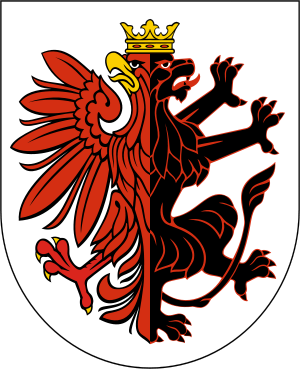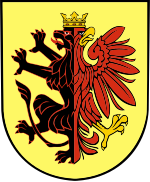Coat of arms of the Kuyavian-Pomeranian Voivodeship
| Coat of arms of the Kuyavian-Pomeranian Voivodeship | |
|---|---|
 | |
| Adopted | 10 July 2000 |
| Blazon | White (silver) Iberian style escutcheon |
| Compartment | Half of a red eagle facing left, joined with a half of a black lion facing right, both animals together wearing a yellow (golden) crown on their joined heads |
| Use | Kuyavian-Pomeranian Voivodeship |
The coat of arms of the Kuyavian-Pomeranian Voivodeship, Poland, consists of a white (silver) escutcheon, with a half of an eagle facing left, joined with a half of a lion facing right, both animals together wearing a yellow (golden) crown on their joined heads. It had been adopted in 2000.
Design
The coat of arms of the Kuyavian-Pomeranian Voivodeship is a white (silver) Iberian style escutcheon with square top and rounded base. It features a charge of Kuyavian Hybride, in the form of a half of a red eagle facing left, joined with a half of a black lion facing right. Both animals together wear a yellow (golden) crown on their joined heads. The eagle has yellow (golden) beak, tongue and claws.
The design and colours of the charge comes from the coat of arms of the voivodeships of Inowrocław, and Brześć Kujawski, used from 14th to 18th centuries. The white (silver) colour of the escutcheon comes from historical coat of arms of the Chełmno Voivodeship, that also featured a white (silver) shield.[1]
History

The design of the coat of arms had originated as the symbol of the Kuyavia. The coat of arms included a charge used in the coat of arms, the Kuyavian Hybride, in the form of a half of a eagle, joined with a half of a lion, both wearing together a crown on their joined heads. The design begun being used in the second half of the 12th century, by the dukes of the Piast dynasty controlling that area. The oldest known usage of that design in the area, comes from the 1268 seal used by duke Ziemomysł of Kuyavia, ruler of the Duchy of Inowrocław.[2] Since 14th century, the charge, featuring a black lion, joined with a red eagle, together wearing a yellow (golden) crown, on a yellow (golden) background, begun being used as a coat of arms of the voivodeships of Inowrocław, and Brześć Kujawski.[3] It was used in those voivodeships until their disestablishment, in 1772, and 1793, respectively.[4]
The current coat of arms had been adopted by the Kuyavian-Pomeranian Voivodeship Sejmik on 10 July 2000.[5]
See also
References
- ^ "Herb Województwa Kujawsko-Pomorskiego". kujawsko-pomorskie.pl (in Polish).
- ^ Marcin Hlebionek: Pieczęcie Piastów kujawskich. Inowrocław, 2011.
- ^ Kasper Niesiecki: Herbarz polski Kaspra Niesieckiego S.J.
- ^ Susan Parman, California State University; Larry Wolff (1994). "Inventing Eastern Europe: The Map of Civilization on the Mind of the Enlightenment". Book review. Stanford, California: Stanford University Press. ISBN 0-804-72314-1. Archived from the original on March 6, 2012.
{{cite journal}}: CS1 maint: uses authors parameter (link) - ^ [https://web.archive.org/web/20120522014818/http://www.kujawsko-pomorskie.pl/files/statut/insygnia/us_444_2000.pdf Uchwała Nr 444/2000 sejmiku województwa kujawsko-pomorskiego z dnia 10 lipca 2000 r. w sprawie ustanowienia wzoru herbu, flagi i sztandaru oraz innych insygniów Województwa Kujawsko-Pomorskiego, 10 July 2000. In: 2000 Journal of Laws of the Kuyavian-Pomeranian Voivodeship, no. 78, position 618. Toruń: Kuyavian-Pomeranian Voivodeship Sejmik. 2000.
